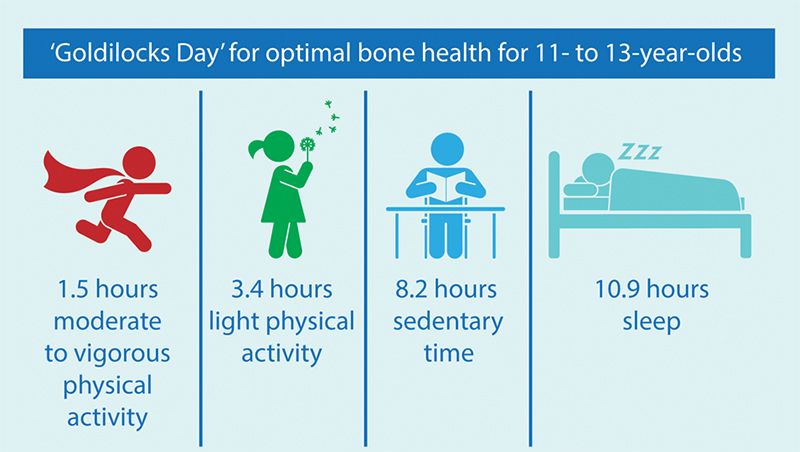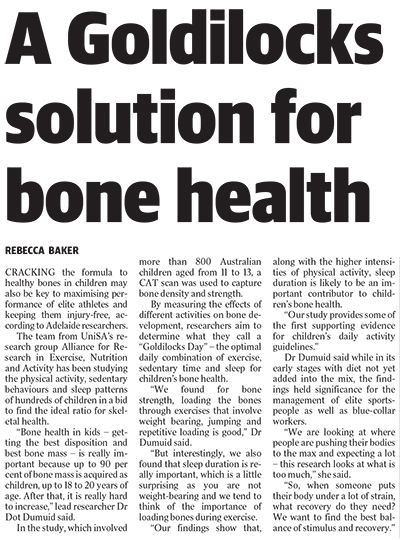The ‘Goldilocks Day’: the just-right approach to children’s bone health
By Annabel Mansfield
 HEALTH
HEALTHNot too little, not too much – Goldilocks’ ‘just right’ approach can now be applied to children’s health as new research by UniSA identifies the best composition of daily activities in a child’s day to maximise bone health and function.
Examining 804 Australian children aged between 11 and 13 years old, the world-first study found that children need more moderate-to-vigorous physical activity, more sleep and less sedentary time to optimise bone health.
The study found the ideal balance of a child’s activities across a 24-hour period comprises:
- 1.5 hours of moderate-to-vigorous physical activity (sports, running around)
- 3.4 hours of light physical activity (walking, doing chores)
- 8.2 hours of sedentary time (studying, sitting at school, reading)
- 10.9 hours of sleep.

Lead researcher, UniSA’s Dr Dot Dumuid, says the findings provide valuable insights for parents, caregivers and clinicians.
“Children’s activities throughout the whole 24-hour day are important for their bone health, but until now, we haven’t known the perfect combination of exercise, sleep and sedentary time,” Dr Dumuid says.
“Higher levels of physical activity are known to be good for children’s bone health, yet we can’t just increase children’s exercise without impacting their other activities.
“In this study, we looked at the interrelating factors of physical activity (both light, and moderate-to-vigorous physical activity), sedentary time and sleep, finding an ideal combination that delivers the best daily balance.
“The ‘Goldilocks Day’ tells us the durations of physical activity, sleep and sitting that are ‘just right’ for children’s optimal bone health.
“Up to 90 per cent of peak bone mass is achieved by age 18-20, which makes this especially important during childhood and adolescence.
“Optimising bone health in children is a key protector against osteoporosis, the leading preventable cause of fracture in adults and a major public health problem with considerable economic and societal costs.”
 The Sunday Mail 18 October 2020
The Sunday Mail 18 October 2020Osteoporosis is common in Australia, with 1.2 million people estimated to have the condition and a further 6.3 million with low bone density. Globally, osteoporosis affects 200 million people, with 75 million cases across Europe, USA and Japan.
In this study, participants were selected from the Child Health CheckPoint study within the Longitudinal Study of Australian Children. Activity data was collected through accelerometer readings (worn for 24 hours a day over an eight-day period), supplemented by self-recorded logs for bed and wake times. Bone measures were recorded via peripheral QCT scans of the leg (ankle and shin) to identify bone density and geometric parameters.
Dr Dumuid says the study also highlights the importance of sleep, especially for boys.
“We always talk about getting enough exercise to help build bones, but for children, it’s vital that they also get enough sleep.
“Curiously, the study also showed that sleep is more important for boys’ bone health than for girls, with boys needing an extra 2.4 hours of sleep a day. However, boys tended to be at earlier stages of pubertal development than girls, causing us to speculate that the need for longer sleep is related to rapidly changing hormonal processes rather than gender.
“By knowing the best balances and interrelations of sleep, exercise and rest, parents and caregivers can guide their child’s daily activities to put them in good stead for future bone health.”
The study was conducted in collaboration with the Murdoch Children’s Research Institute; The University of Melbourne; The Royal Children’s Hospital; The University of Auckland; the University of Turku; Turku University Hospital; and the University of Tasmania.
The article, Goldilocks Day for Children's Skeletal Health: Compositional Data Analysis of 24‐Hour Activity Behaviours, is published in the Journal of Bone and Mineral Research.
Dr Dumuid has multiple highly cited papers which are ranked among the top 1 per cent of papers in her field globally (Clarivate Web of Science, Data retrieved 16-10-20).
Other Stories
- The ‘Goldilocks Day’: the just-right approach to children’s bone health
- World-first study strengthens case for banning whips in horse racing
- Optus and UniSA collaborate to drive cybersecurity and data science innovation in SA
- Cancer treatment could be replicated for COVID-19
- From the Vice Chancellor
- Achievements and Announcements
- The music stopped for SA’s party drug scene during lockdown
- Explainer video: What are x-rays and how safe are they?
- NSW wants to change rules on suspending and expelling students. How does SA compare?
- Images of research invite us to view the world differently
- Caps and gowns make a popular return as first UniSA graduates cross the stage since COVID-19
- Aboriginal led edition of student magazine proves an Australian first
- The latest books from UniSA researchers
- In Pictures: First graduation ceremonies of 2020




